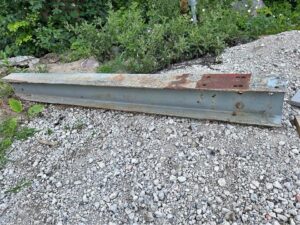Did you know that mobile homes rely on a crucial component called the mobile home I-Beam? This steel structure plays a vital role in providing support and stability to these trailers. Acting as the backbone of the construction, the mobile home I-Beam connects the chassis to the rest of the home, ensuring durability and structural integrity.
Mobile Home I-Beam Measurement
With its robust design, this I-Beam is specifically engineered for mobile homes, making it an essential feature in their construction. Its strength allows these homes to withstand various environmental conditions while providing a safe and secure living space.

So next time you step into a mobile home, take a moment to appreciate the hidden hero beneath your feet—the sturdy mobile home I-Beam that keeps everything together.
Purpose and Function of “I” Beams in Mobile Homes
Distribute weight evenly throughout the structure
Resist bending and twisting forces
Support the walls, floors, and roof of the mobile home
Ensure structural integrity and safety
“I” beams play a crucial role in mobile homes by providing stability and support to the entire structure. These beams are specifically designed to distribute weight evenly, ensuring that the mobile home remains balanced.
One of their primary functions is to resist bending and twisting forces. As mobile homes are constantly subjected to various external pressures like wind or movement during transportation, it is essential to have sturdy beams that can withstand these forces without compromising the integrity of the structure.
What Do “I” Beams Do
“I” beams support the walls, floors, and roof of the mobile home. They act as a backbone, keeping everything securely in place. Without these beams, the structure would be prone to sagging or collapsing under its own weight.
Furthermore, these beams contribute significantly to ensuring structural integrity and safety within a mobile home. By providing a strong framework, they help prevent potential hazards such as structural failures or collapses.
To summarize, “I” beams serve multiple purposes in mobile homes. They distribute weight evenly throughout the structure, resist bending and twisting forces, support walls/floors/roofing components, and ultimately ensure structural integrity and safety. Their presence is vital for maintaining stability and durability in mobile homes.

You might be interested in our article: How Much Weight Can a Mobile Home Floor Hold?
Determining Measurements and Span of “I” Beams
Determining the measurements and span of “I” beams is crucial. These steel beams play a vital role in providing structural support and ensuring the safety and stability of the building. Let’s explore some key factors to consider when determining the dimensions and span of these beams.
Load-bearing capacity and building codes:
Ensure compliance with local building codes that dictate the minimum load-bearing requirements.
Consider the weight distribution on the beam, including any additional loads from roofs, walls, or other structures.
Consult with a structural engineer to accurately determine the required load-bearing capacity.
Calculating span based on distance between supports:
Measure the distance between supports or columns where the beam will be installed.
Determine an appropriate span length based on this measurement.
Take into account any potential deflection or bending that may occur under load.
Make Sure You Have the Right Size “I” Beam
Choosing an appropriate beam size based on weight requirements:
Evaluate the total weight that will be placed on the beam, including both static and dynamic loads.
Consider factors such as torsional stiffness, plan area, amount of axles, and rail spacing for mobile homes with wheels.
Select a steel beam size that can effectively handle these weight requirements while ensuring structural integrity.
Consulting with professionals for accurate measurements:
Engage a qualified structural engineer or professional contractor experienced in mobile home construction.
Seek their expertise to determine precise measurements based on your specific project requirements.
By considering these factors and consulting with professionals, you can ensure that your mobile home’s “I” beams are properly sized and spaced for optimal safety and performance. Remember to adhere to local building codes throughout the process to guarantee compliance with regulations.

Types of Mobile Home Foundations Utilizing “I” Beams
Pier-and-beam foundation with I-Beam supports
I-Beams are used as vertical supports in a pier-and-beam foundation for mobile homes.
These beams provide stability and strength to the structure, ensuring it can withstand the weight of the home.
Crawl space foundation using I-Beams as floor joists
In a crawl space foundation, I-Beams serve as floor joists, supporting the mobile home’s flooring.
These I-Beams are essential for distributing the weight evenly and preventing sagging or structural issues.
Slab-on-grade foundation with I-Beam reinforcement
A slab-on-grade foundation incorporates I-Beam reinforcement beneath the concrete slab.
The I-Beams add extra strength and support to the foundation, making it more durable and stable.
Basement foundation incorporating I-Beams for added strength
For mobile homes with basement foundations, I-Beams are utilized to enhance structural integrity.
These I-Beams provide additional strength to the basement walls and support the weight of the mobile home above.
Mobile Home I-Beam Measurement: Different Foundations
By utilizing different types of foundations that incorporate “I” beams, mobile homes can be securely supported. Whether it’s a pier-and-beam foundation with vertical I-Beam supports or a crawl space foundation using I-Beams as floor joists, these structures ensure stability and prevent potential issues like sagging or shifting. A slab-on-grade foundation reinforced with I-Beams offers durability and longevity. For those opting for basement foundations, incorporating I-Beams provides added strength to withstand both external forces and the weight of the mobile home above. With these various options available, individuals can choose a suitable mobile home foundation that utilizes “I” beams according to their specific needs.

Exploring Different Foundation Options for Mobile Homes
Pier-and-beam foundations provide easy access to utilities
Mobile homes can be supported by pier-and-beam foundations, which offer several advantages.
These foundations consist of concrete piers that are placed beneath the home, providing stability and support.
One key benefit is the easy access they provide to utilities such as plumbing and electrical systems.
If any repairs or maintenance work needs to be done, it can be easily carried out without major disruptions.
This foundation system also allows for adjustments if the ground settles or shifts over time.
Crawl space foundations offer additional storage space
Another option for mobile home foundations is a crawl space foundation.
With this type of foundation, the home is elevated off the ground on footings or supports.
The open area beneath the home creates a crawl space that can be used for storage purposes.
Homeowners can take advantage of this extra space to store seasonal items or belongings that are not frequently used.
It provides convenient accessibility while keeping these items protected from the elements.
Slab-on-grade foundations are low maintenance
Slab-on-grade foundations are a popular choice for mobile homes due to their simplicity and low maintenance requirements.
This type of foundation involves pouring a concrete slab directly onto the ground surface.
It eliminates the need for any crawl spaces or basements, making it easier to maintain and clean around the home.
Slab-on-grade foundations also offer good insulation properties, helping to regulate temperature inside the mobile home.
Basement foundations provide extra living or storage areas
For those looking for additional living or storage areas in their mobile homes, basement foundations are an option worth considering.
Basements allow homeowners to maximize their available space by adding extra rooms or creating storage areas below ground level.
These underground spaces can serve as recreational rooms, offices, workshops, or even guest bedrooms.
It’s important to note that building a basement foundation may require complying with local regulations and state laws.
Homeowners should consult with professionals to ensure compliance and proper construction techniques.
By exploring different foundation options such as pier-and-beam, crawl space, slab-on-grade, and basement foundations, mobile home owners have the opportunity to choose the best fit for their needs. Each type offers unique benefits, whether it’s easy access to utilities, additional storage space, low maintenance requirements, or extra living areas. Consider your preferences and requirements when deciding on the most suitable foundation for your mobile home.

Choosing the Appropriate Foundation for Your Mobile Home
Evaluate soil conditions, climate, and local regulations:
Before deciding on a foundation for your mobile home, it’s crucial to assess the soil conditions of your site. Different types of soil require different foundation systems to ensure stability and prevent shifting or settling.
Consider the climate in your area as well. Extreme weather conditions like high winds, heavy rain, or freezing temperatures may impact the choice of foundation.
Familiarize yourself with local regulations governing mobile home foundations. Some areas have specific requirements that must be met for safety and compliance.
Assess budget constraints when selecting a foundation type:
Keep in mind your budget limitations when choosing a foundation for your mobile home. Different options come with varying costs associated with materials, labor, and ongoing maintenance.
A concrete slab foundation is a popular choice due to its affordability and durability. It provides a solid base for the mobile home frame while minimizing costs.
Alternatively, if budget allows, you might consider a permanent foundation that offers long-term stability and can increase the value of your manufactured home.
Factor in long-term maintenance requirements:
When selecting a foundation type, consider the long-term maintenance needs it may entail. Some foundations require regular inspections or repairs to ensure their structural integrity over time.
For instance, if you opt for a raised foundation on piers or blocks, periodic checks are necessary to ensure proper support and address any issues promptly.
On the other hand, concrete slab foundations generally require minimal maintenance but may need occasional sealing or repairs depending on wear and tear.
Hire professionals to assess site suitability:
To determine which foundation option is most suitable for your mobile home frame and site conditions, it’s advisable to hire professionals experienced in mobile home installations.
These experts can evaluate factors such as soil composition, drainage patterns, slope stability, and proximity to roads or bodies of water.
By relying on their expertise, you can make an informed decision about the foundation that best suits your mobile home’s needs while ensuring safety and compliance.
By considering soil conditions, climate, local regulations, budget constraints, long-term maintenance requirements, and seeking professional advice, you can confidently choose the appropriate foundation for your mobile home. Remember to evaluate all factors before making a final decision to ensure stability and longevity.

You might also be interested in our article:
Mobile Home Axles and Hitches: Removal & Transport Guide
Key Takeaways on Mobile Home I-Beam Measurement
In conclusion, understanding the key aspects of mobile home I-Beams measurement is crucial. Here are some key takeaways to keep in mind:
Purpose and Function: “i” beams play a vital role in providing structural support and stability to mobile homes. They distribute the weight evenly across the foundation, ensuring durability and safety.
Measurements and Span: Accurately determining the measurements and span of I-Beams is essential for maintaining the structural integrity of your mobile home. Proper calculations will help prevent sagging or excessive stress on the foundation.
Types of Foundations: Various types of foundations utilize I-Beams, including pier-and-beam, slab-on-grade, and crawl space foundations. Each option has its own advantages and considerations, so it’s important to choose one that suits your specific needs.
Exploring Foundation Options: When selecting a foundation for your mobile home, consider factors such as soil conditions, local building codes, climate considerations, and budget constraints. These factors will influence which foundation option is most suitable for you.
Call-to-Action: If you’re unsure about which foundation option is best for your mobile home or need assistance with measuring or installing I-Beams, consult with a professional contractor experienced in mobile home construction.
FAQs: Mobile Home I-Beam Measurement
How do I determine if my mobile home needs additional support with I-Beams?
If you notice any signs of sagging floors or walls, cracks in drywall, or doors that don’t close properly, it may indicate a need for additional support using I-Beams.
Can I install I-Beams myself?
While some homeowners may have the skills to install I-Beams themselves, it’s generally recommended to hire a professional contractor who has experience working with mobile homes to ensure proper installation.
Are there any alternatives to using I-Beams for mobile home foundations?
Yes, other foundation options such as helical piers or concrete footings can be used depending on the specific needs and requirements of your mobile home.
How long do I-Beams typically last?
With proper maintenance, I-Beams can last for several decades. However, it’s important to regularly inspect them for signs of wear and tear and address any issues promptly.
Can I retrofit my existing mobile home foundation with I-Beams?
In many cases, it is possible to retrofit an existing foundation with additional support using I-Beams. Consult with a professional contractor to assess the feasibility and cost-effectiveness of such a project.
You might also be interested i our articles:
Top Mobile Home Security Systems 2023
